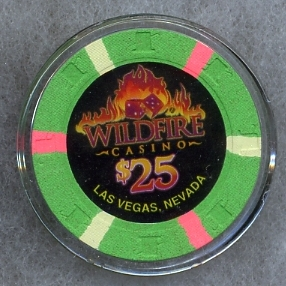The anatomy of a chip can be basically broken down into the Base Color, the Inserts (number and color), the Mold, and the Inlay
In this first example, the Base Color is green, there are three pink and three white inserts, there is a hat and cane mold, and there is a black inlay with the casino logo.
The Base Color is the primary color of the body of the chip. Interestingly, the Base Color can sometimes be hard to determine if no particular color seems to be dominant on the chip.
The Inserts are injected into the body of the chips (they cannot be scratched off) and are some color(s) other than the Base Color.
The Mold is a pattern that is imprinted onto both sides of the chip - typically around the edge outside of the Inlay. There are many different mold types. This chip above has a "house mold" - in imprint of the casino's (house's) name or logo.
Finally, the Inlay is located at the center of the chip and usually contains the casino's logo and the chip denomination. Some Inserts are solid through the center of the chip while others are paper or plastic decals that are glued onto either side of the chip. Some chips even have metal (aluminum, brass, etc.) inlays with the logo/denom stamped into the metal.

Contributed By: Jay Sands & Bryan Jimison